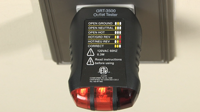Changing an electrical outlet/receptacle may seem intimidating, but it’s an easy project, as long as you follow the proper procedures for working with electrical wiring. Watch this video to learn how to do this project, and start building your skills for working with electricity.
In the first video on running electrical wire and cable through the wall, we ran wires up to a spot directly behind where our flat-panel TV is mounted. In this video, we’ll finish the job by installing an electrical box and receptacles where we can plug in our TV wires so they’re hidden from view.
Today I’ll show you how to install the new electrical boxes and hook up the wires that we ran through the wall to the new receptacle we installed behind the TV. We’ll talk about some of the different types of electrical boxes and TV component receptacles. Then we’ll finish by repairing our drywall and repainting.
Again, if you have any hesitation about working with electricity and hooking up electrical wiring components, call a licensed electrician to do the work. But if you’re ready, to tackle this project, then let’s get started.
When selecting a new electrical box for your project, you have several options to choose from. The first is deciding between a metal or plastic box. Our existing box was metal, but we’re opting to replace it with a plastic box, which meets code when running non-metallic sheathed cable, which is what we’re doing. We’ll also be using a box designed for "Old Work," which refers to existing wall installations, as opposed to new construction applications. Old Work boxes have these "ears" that flip out and clamp to the back of the drywall when tightened. New work boxes like this one are fastened to a wall stud with these supplied nails or they can be screwed to the stud face through this metal bracket. For more information on selecting the right electrical box, see our frequently asked questions for this video.
After removing the old outlet and single gang box, we’ll prepare to install the new double gang box by placing it over one side of the existing cutout and tracing the perimeter of the rest of the box on the wall. Then, enlarge the hole using a drywall saw. Fish the two new wires through the wall to the opening. Before installing the new box, first punch through the knockout tabs on the back of the box using a hammer and screwdriver. This is where the electrical cables will enter the box. It’s also a good idea to place this plastic divider in the center grooves of the box to help shield our HDMI and coaxial cable from the electrical line voltage cable. This will help prevent electromagnetic interference with the signal.
On the low voltage side of the box, we’ll hook up our coax cable and HDMI cords to the back of the plate before screwing it into the gang box. The other option is to use this in-wall cable access port, which has brushes to conceal the wire coming out of the wall. This would facilitate using one coax and HDMI cord from all the way from the TV to the cable box or to another accessory, such as a DVD player. It’s largely a matter of preference.
On the line voltage side, we’ll strip the ends of our new electrical cable using these wire strippers, then run the wires through the knockouts and connect both existing and new cable to the outlet, connecting both black wires to the hot side and both white wires to neutral side. For the ground wires, we’ll create a pigtail and connect it to the green ground screw on the receptacle. Then connect the ground wires to each end of the pigtail. For this wire connection we’ll use a wire cap wrapped in electrical tape. Now we’ll screw the receptacle into the gang box. For more information on the proper way to wire outlets, see our video, "Replacing an Electrical Receptacle."
Pull the wires through the knockouts and fasten the box to the wall. As we said earlier, this box is for Old Work, or remodeling applications. It has these ears that clamp on to the back of the drywall to hold the box securely in place. Using a screwdriver or cordless drill, simply screw it until it’s clamped tight to the back of the drywall. That should do it.
Now, we’ll repeat the same process for the box we’ll install behind the TV, hooking up the wires and installing the receptacles. The only difference is that we’ll use a surge suppressor outlet to protect the TV from electrical surges.
Once everything is hooked up, flip the breaker back on to test it to make sure everything works. It’s always a relief when you find out that you’ve done it correctly.
Now, we’ll conceal our tracks by replacing the drywall. But first, we’ll install these metal clips on the stud directly in front of the holes we drilled to protect the wiring from future drywall screws or nails that could puncture our wiring. Now, we can begin the process of reinstalling the drywall. In our case, we can reuse the existing drywall since we were careful not to destroy it when removing it at the beginning of our project. For more information on this procedure, see our video, fixing holes in drywall.
There you have it. Now we can enjoy watching TV without being distracted by all those unsightly wires. And all it took was an understanding of how to fish wire through a wall, as well as some basic electrical wiring skills, which we learned from our local independent home improvement retailer.
Read Video Transcript

